| | 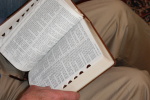
This classic Christian hymn, How Firm a Foundation, fulfills its own title in laying a firm foundation of faith by means of the words of God, which words are found in scripture. The text is believed to have been written in the latter half of the eighteenth century, so the scriptures that form its basis are found in the Bible, most likely the King James Version published in 1611. The hymn contains seven verses and the structure of the work is unusual in that the form of the first two verses is written in third person, with the following verses written in first person as the voice of the Lord speaking from the scriptures. The final seventh verse can also be read as individual first person, allowing each reader or singer to make their own commitment to do as the Savior would do in ministering to others. The hymn text begins with instruction to those who have fled unto the Lord for refuge that His word should be their foundation. The Apostle Paul wrote to the Corinthians in the New Testament, telling them that Jesus Christ is the foundation and no man can lay any other. The works that are built on that foundation will be made manifest and “fire shall try every man’s work of what sort it is.” (As defined in the Book of Genesis, the Biblical term ‘man’ refers to both men and women.) The hymn text subsequently describes both the fiery trials referred to by Paul and the aid, strength, blessings, and comfort the Lord will provide to sustain us through them. The second verse describes various conditions people may find themselves in that will try them, and then promises that the Lord can provide strength or succor for every circumstance. (In the original work, the author used the word ‘strength’ which was changed to ‘succour’ sometime before 1835. Succour (or succor) means: ‘relief,’ and ‘to go to the aid of.’) As written in the Epistle of Paul to the Hebrews, the Lord in all things was made like unto his brethren “For in that he himself hath suffered being tempted, he is able to succour them that are tempted.” The third verse begins the Lord’s response in first person, and is based on the Book of the Prophet Isaiah, Chapter 41, verse 10: “Fear thou not; for I am with thee; be not dismayed; for I am thy God;…” The fourth verse is based on Isaiah, Chapter 43, verse 2: “When thou passest through the waters, I will be with thee; and through the rivers, they shall not overflow thee…” The fifth verse has reference to the description of trial by fire in First Corinthians, as mentioned above, and the description of the Savior’s grace found in Second Corinthians: “…My grace is sufficient for thee:…” The seventh verse contains the promise made in Hebrews, Chapter 13, verse 5: “…for he hath said, I will never leave thee, nor forsake thee.” The hymn “How Firm a Foundation” is believed to have first been published by a Baptist pastor, Dr. John Rippon, at London, England, in a 1787 hymn collection titled: “Selection of Hymns from the Best Authors, Intended to be an Appendix to Dr. Watts’ Psalms and Hymns.” It is said that by 1836 eleven editions of the collection had been printed in England and one printed in America. The hymn’s first appearance in America was in the1790 hymnal printed by the Philadelphia Baptist Association. In 1792, Reverend Rippon’s book was reprinted in its entirety in New York. “How Firm a Foundation” became well known and loved in America, and it is said that its popularity has been more widespread and lasting in the United States than in its country of origin. It is reported to have been sung at the funerals of Theodore Roosevelt, Woodrow Wilson and Robert E. Lee. It is said that after midnight on Christmas Eve of 1898 during the Spanish-American war, troops stationed along the hills near Havana, Cuba sang the hymn, beginning with one baritone voice until the entire army, Protestant and Catholic, northern and southern, were all singing together. Another account is given of the words of the seventh verse being heard as an answer to a prayer by Amanda Smith as, under the threat of death if heard praying, she hid to pray aloud in a Missouri cornfield. The Haun’s Mill massacre of 1838 had left her a widow to care for her wounded child with a few others at the mercy of the mobbers. The words of the hymn, that she would not be forsaken, took away her fear and she was later able to confront the mob and turn their hearts. As mentioned above, and perhaps not surprising, some of the author’s words have been changed over the ensuing 200-plus years to suit the different tunes and editors. Even by 1835, forty-eight years later, when Emma Smith included the hymn in the first collection of hymns for The Church of Jesus Christ of Latter-day Saints (LDS), changes had been made to a few of the words. 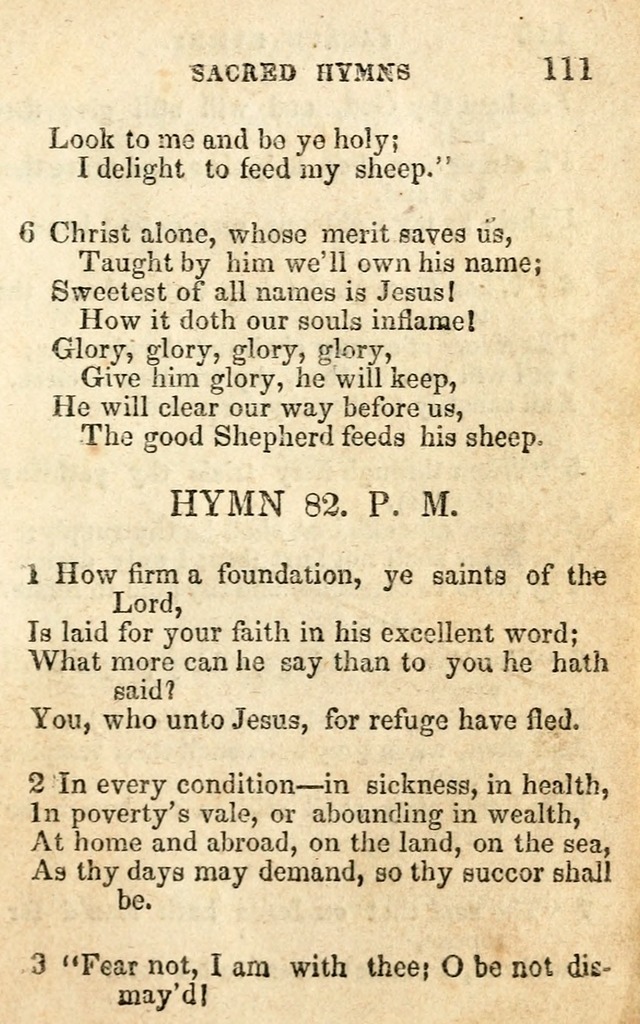
Reviewing the meanings of some of the author’s poetic words not commonly used today brings additional clarity to his intent. “Vale:” valley. “Abounding:” supplied with a great quantity. “Abroad:” away from one’s home. “Omnipotent:” having unlimited authority and influence. “Woe:” ruinous trouble, affliction, grief, sorrow. “Dross:” the scum of impurities that forms on the surface of molten metal. “Sanctify:” to set apart to a sacred purpose. “Hoary:” gray or white with age. “Borne:” carried, sustained. “Repose:” rest, peace, tranquility. The hymn has been included in the LDS hymnals since 1835. It is not definitely known which tune was used with the first edition. As can be seen in the photo above, the 1835 hymnal contained only the text. In the 1985 LDS Hymnal the text of the last phrase of the first verse was modified from the previous edition. “You who unto Jesus…” was changed to, “Who unto the Savior…” The original wording was felt to be awkward. The music also was transposed to a lower key, with some slight modifications in notation and harmony to make it easier for congregational singing. The essential message of the hymn remains unchanged and is a powerful instructor, comforter, testifier and motivator.
| | 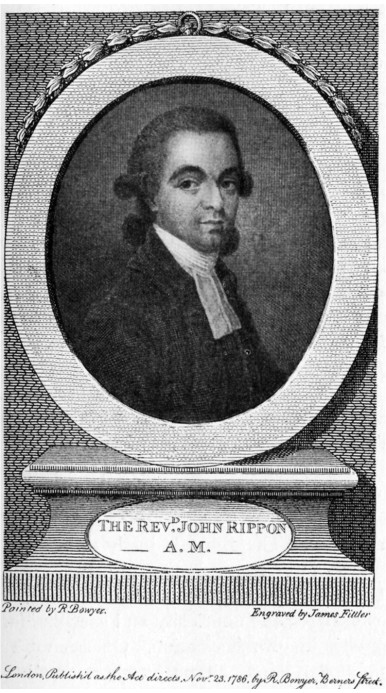 Reverend Dr. John Rippon was born in April of 1751 at Tiverton, Devonshire, England. Tiverton is in southern England, about 65 miles southwest of Bristol. Reverend Dr. John Rippon was born in April of 1751 at Tiverton, Devonshire, England. Tiverton is in southern England, about 65 miles southwest of Bristol.
John attended the theological Baptist College in Bristol, and in 1775 traveled east across the country and became minister, or pastor, of Carter Lane Baptist Church, central London, where he served the rest of his life. Amid his other duties John published a memoir of his predecessor, Rev. John Gill. Although it is reported that Reverend Rippon was one of the best respected and influential ministers outside the Church of England at that time, and for twelve years edited the Baptist Annual Register, he is best remembered for his work as a hymn compiler and editor. Prior to the mid-eighteenth century it is said that the Baptists did not engage in congregational singing, but at that time were affected by the stimulus to hymn singing given by the publication of Isaac Watts’ hymns, and others. They then began working on their own hymns and hymn-books. Dr. John Rippon’s 1787 hymn-book “A Selection of Hymns from the Best Authors, Intended as an Appendix to Dr. Watts’ Psalms and Hymns,” was one of the most influential of these and contained 588 hymns. Of these, 300 had not previously been published, including the most well-known of the collection, “How Firm a Foundation.” It is said that this collection was reprinted twenty-seven times, totaling over 200,000 copies. At the age of 85, after a lifetime of service, Reverend Rippon passed away in December of 1836. It is interesting to note that he was buried at Bunhill Fields, an unconsecrated London burial ground for plague victims and dissenters from the Church of England. This burial ground also contains the grave of the notable hymnist, Isaac Watts, to whose psalms and hymns the Rev. Rippon’s 1787 hymn collection was intended to be an appendix.
How Firm a Foundation - Original 1787 Text with current text changes in parentheses: How firm a Foundation, ye Saints of the Lord, Is laid for your Faith in his excellent Word; What more can he say than to you he hath said? You, who unto Jesus for Refuge have fled? (Who unto the Savior for refuge have fled?) In every Condition, in Sickness, in Health, In Poverty’s Vale, or abounding in Wealth; At Home and Abroad, on the Land on the Sea, (At home or abroad, on the land or the sea -) As thy Days may demand, shall thy Strength ever be. (As thy days may demand, so thy succor shall be.) Fear not, I am with thee; O be not dismay’d, I, I am thy God and will still give thee Aid; (For I am thy God and will still give thee aid.) I’ll strengthen thee, help thee, and cause thee to stand, Upheld by my righteous omnipotent Hand. When thro’ the deep Waters I call thee to go, The Rivers of Woe shall not thee overflow; (The rivers of sorrow shall not thee o’erflow,) For I will be with thee, thy Troubles to bless, And sanctify to thee, thy deepest Distress. When thro’ fiery Trials thy Pathway shall lie, My grace all sufficient shall be thy supply; The Flame shall not hurt thee; I only design Thy Dross to consume, and thy Gold to refine. Even down to old Age, all my People shall prove My sovereign, eternal, unchangeable Love; And when hoary hairs shall their Temples adorn, (And then when gray hair shall their temples adorn,) Like lambs shall they still in my bosom be borne. The Soul that on Jesus hath lean’d for Repose, I will not, I will not, desert to his Foes; (I will not, I cannot, desert to his foes;) That Soul, tho’ all Hell should endeavor to shake, I’ll never - no never - no never forsake. | |
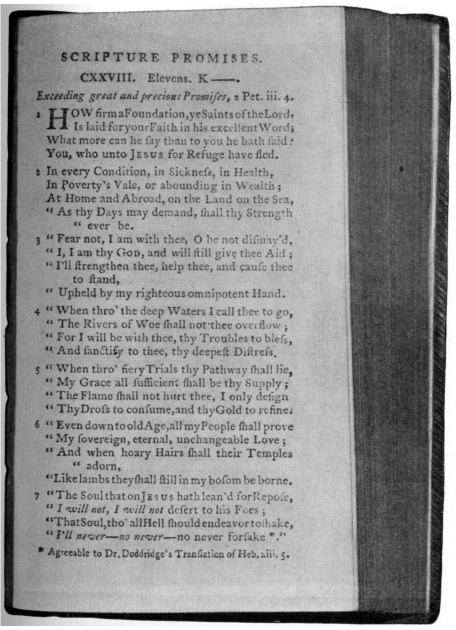 In his 1787 hymnbook Reverend Rippon identified the author of “How Firm a Foundation” only as “K--.” The mystery of the author’s identity has been given quite a bit of attention over the years but has not been absolutely resolved. Authorship has been ascribed variously to Thomas Kirkham, a hymn publisher; George Keith, a bookseller and hymn writer; and Robert Keen (Keene) a precentor, or singing leader, at Dr. Rippon’s church. Records of interviews with members of Dr. Rippon’s church have conveyed the belief that R. Keen(e) was the author, and this appears to be the most widely accepted conclusion. In his 1787 hymnbook Reverend Rippon identified the author of “How Firm a Foundation” only as “K--.” The mystery of the author’s identity has been given quite a bit of attention over the years but has not been absolutely resolved. Authorship has been ascribed variously to Thomas Kirkham, a hymn publisher; George Keith, a bookseller and hymn writer; and Robert Keen (Keene) a precentor, or singing leader, at Dr. Rippon’s church. Records of interviews with members of Dr. Rippon’s church have conveyed the belief that R. Keen(e) was the author, and this appears to be the most widely accepted conclusion.
In the 1948 edition of the LDS Hymnal, authorship was listed as “Kirkham,” however, in the 1985 LDS Hymnal; it is “Attributed to Robert Keen.” Little is known of Robert Keen, or Keene, (possibly Richard Keen) except that he was the music/singing leader during part of Reverend Rippon’s ministry at Carter Lane Baptist Church, from 1776 to 1793, and is believed to have composed several hymns.
The Composer
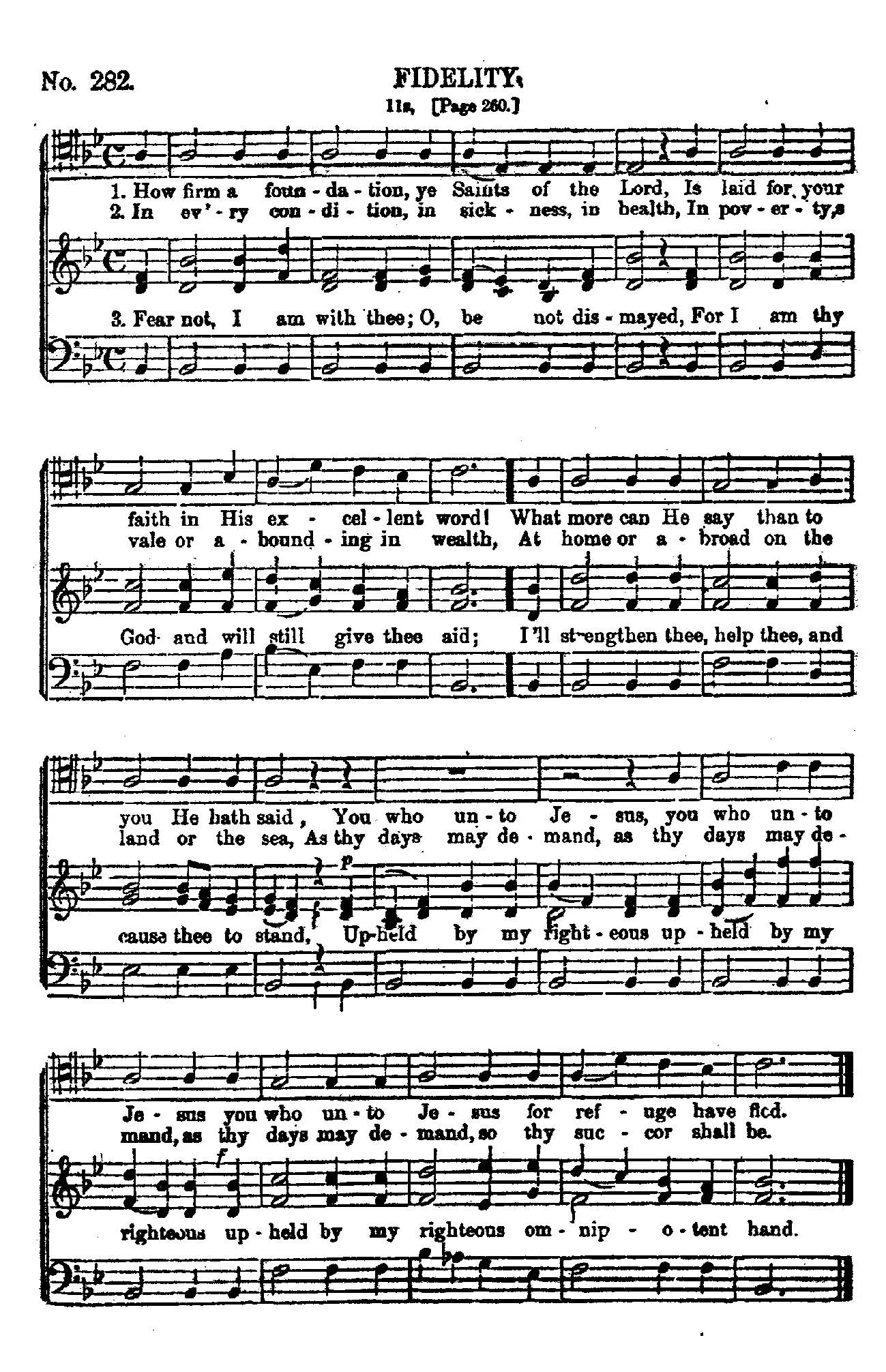 Since its first appearance, “How Firm a Foundation” is reported to have been published in over 1700 hymnals by many different denominations, and has been set to over ten different tunes. One of the most popular is ADESTE FIDELES, the tune commonly associated with the Christmas hymn “Oh, Come All Ye Faithful.” It is also sung to Johann Haydn’s hymn tune LYONS, commonly associated with “How Wondrous and Great.” Since its first appearance, “How Firm a Foundation” is reported to have been published in over 1700 hymnals by many different denominations, and has been set to over ten different tunes. One of the most popular is ADESTE FIDELES, the tune commonly associated with the Christmas hymn “Oh, Come All Ye Faithful.” It is also sung to Johann Haydn’s hymn tune LYONS, commonly associated with “How Wondrous and Great.” It is reported that the 1880 tune book published by Eliza R. Snow for the LDS Primary Association used the ADESTE FIDELES tune; however, the familiar tune sung by Latter-day Saints today is known as FIDELITY and was used in the 1889 Latter-day Saints Psalmody and subsequent LDS Hymnbooks. By association of the FIDELITY tune with other denominational texts that use it, the composition has been attributed to J. Ellis. Unfortunately, no known biographical information is available about J. Ellis. The FIDELITY tune in 4/4 time allows for repeated text in the last phrase of each verse, which does not occur in other tunes. The repetition gives emphasis to the great message of the text. |